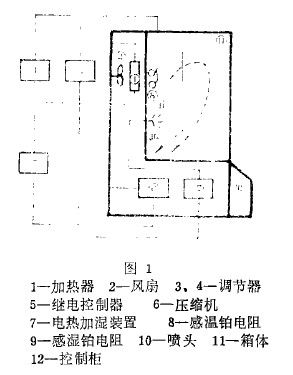With the development of science in our country, in order to facilitate the cultivation and storage of microorganisms, bacteria, viruses, and animal and plant tissues and cells, we have developed a relatively small and constant temperature and humidity electric constant temperature incubator. Figure 1 is a schematic diagram of the structure of this incubator. It consists of heating, cooling, humidification, and a corresponding control system. Its working principle is that when the temperature deviates from a given value, if the temperature rises, the temperature-sensing bridge output signal will be amplified and controlled to cool the refrigeration system, forcing the temperature to drop; if the temperature is lower than a given value, the temperature control system will work, The heater heats up and the temperature rises to bring the temperature to equilibrium. If the cabinet needs to be humidified, the signal from the sensor bridge is output, the humidity control system is operated, and the electric humidifier steam is sprayed wet; otherwise, the refrigeration system is required to work to dehumidify during dehumidification so as to achieve the purpose of dehumidification so as to keep the humidity constant. 1 The theory of measuring humidity According to the use of wet and dry bulb temperature to determine the state of air (Figure 2). The dry-bulb temperature T2 in the test indicates the actual temperature in the air. Under the condition that the relative humidity of the air is constant, the evaporation of moisture on the wet-bulb gauze can be considered to be stable, and the required heat is also certain. Therefore, when the relative humidity of the air is relatively small, the surface of the wet bulb evaporates more quickly, and the amount of heat required for evaporation also increases. Therefore, the temperature difference between wet and dry bulbs is large. Conversely, if the relative humidity in the air is large, the temperature difference between wet and dry bulbs is small. When the relative humidity is 100%, the water no longer evaporates, indicating that the wet bulb temperature is the same. It can be seen that in a certain air state, the temperature difference between wet and dry bulbs also reflects the relative humidity in the air. This physical phenomenon is based on the balance between the wet-bulb temperature T: lower than the ambient temperature T, the absorbed heat Q, and the amount of heat lost by the evaporation of water on the gauze Q: should be equal, ie, mouth, mouth 2. According to the principle of heat transfer, when two objects of different temperatures are in contact, objects with high temperature will transfer heat to objects with low temperature, and the same will happen when water is brought into contact with air. 2 small inertia electric humidifier In order to meet the requirements of humidity control accuracy, reducing the inertia of the humidifier and improving its dynamic characteristics are the key technologies for controlling humidity. FIG. 6 is a schematic diagram of the structural principle of the electric humidifier. When humidification is required, the humidity control circuit turns on the heater of the humidifier to heat the water in the container until it boils to generate steam. Steam as a quantity of moisture is injected into the tank through the exhaust pipe. If the float ball sinks, it indicates that water needs to be added to the vessel. At this time, the micro switch contact is opened, and the solenoid valve of the inlet pipe is opened to feed water. When the water is full, the float rises, the top bar touches the micro switch contact closure, the solenoid valve closes the inlet pipe, and stops adding water. Due to the small container, the amount of water is small and the inertia time is short. The amount of moisture in the air indicates the amount of water vapor in the air. The air is a mixture of air and water vapor. The amount of water vapor in the air determines the degree of air humidity. Assume that the operating temperature in the box is T50°C, the relative humidity requirement is A=95%, and the box is at an atmospheric pressure. The calculation result shows that the maximum amount of humidity required for the box volume of 150 liters is 12.65 grams. Therefore, the volume of the humidifier can be made into a very small device. 3. Test situation After the incubator installed, the situation was good, the design was proved to be reasonable, and the system circuit was stable and reliable. Figure 8 shows the two sets of curves recorded in this experiment (stabilized). (1) Temperature range 0 to 50 °C, resolution 0.1 °C, fluctuation accuracy ± 0.5 °C. The humidity range is 50%~95%R. H, 1% resolution, fluctuation accuracy ± 7% RH. (2) From the perspective of temperature and humidity curves, feed forward solution control is adopted, and the control accuracy of temperature and humidity is significantly improved. (3) A slight modification of the incubator can be used as a small artificial climate chamber, instrumentation type test chamber to expand its use. Steel Link Chain,Stainless Chain Link,Stainless Steel Twist Link Chain ,Stainless Steel Short Link Chain Xinghua City Tianli Stainless Steel Products Co., Ltd. , https://www.tlsteels.com
